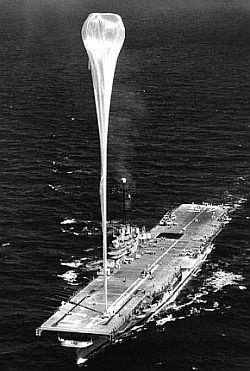Valley Forge (CV-45) was laid down on 7 September 1944 by the Philadelphia Navy Yard and launched on 18 November 1944. Following fitting out, the new carrier got underway on 24 January 1947 for shakedown training. On March the same year made a first duty cruise on East Asia and Australia, and returned home via the Suez channel and the Mediterranean Sea.

Valley Forge deployed to the Far East, departing the west coast on 1 May 1950 and while anchored in Hong Kong harbor on 25 June, the warship received news that North Korean forces had begun streaming across the 38th parallel into South Korea. The ship joined the operations theather in early July. During this period, Valley Forge's Air Group 5 made numerous daily strikes against North Korean targets including the first carrier air strike of the conflict. Returning to San Diego for overhaul on 1 December 1950, returned at once back to Korea rendezvousing with Task Force 77 three days before Christmas of 1950. The ship recommenced air strikes on the 23d, the first of three months of concentrated air operations. Valley Forge returned to the United States in the summer of 1952 but was again deployed to the Far East late in the year. In October 1952, she was reclassified an attack carrier and redesignated CVA-45 beginning 1953 with strikes against supply dumps and troop billeting areas behind the front lines. Finally the ship left the Korean coast and returned to San Diego on 25 June 1953.

Then, Valley Forge was transferred to the Atlantic Fleet and reclassified, this time to an antisubmarine warfare support carrier, and redesignated CVS-45. She was refitted for her new duties at the Norfolk Naval Shipyard and then rejoined the Fleet in January 1954. The face-lifted carrier soon got underway to conduct exercises to develop and perfect the techniques and capabilities needed to carry out her new duties.
During maneuvers in the Caribbean the ship served as launch base for a series of stratospheric balloon launches under a special program of the NAVY's Ofiice of Naval Research to study cosmic rays. A total of eight big plastic balloons were launched from the deck of the carrier during the last days of January, 1960 under the generic denomination of "Operation Skyhook". This widely publicized scientific experiment involved the launching of three of the largest balloons then ever fabricated, carrying devices to measure and record primary cosmic ray emissions at an altitude of between 18 and 22 miles above the earth's surface.
The carrier participated this same year in a Project Mercury operation, and her helicopters retrieved the space capsule launched by a rocket from Cape Canaveral on 19 December.
When the Gulf Gulf of Tonkin breaked in August 1964 Valley Forge -wich after a massive overhaul was adapted as amphibious assault ship- provided logistic support and troops transportation in several cruises until 22 August 1969, the day on which she received a message announcing her forthcoming inactivation. The ship returned to Long Beach on 31 October to prepare for decommissioning and on 16 January 1970, Valley Forge was placed out of commission. After the failure of attempts to raise funds for using the ship as a museum, she was sold for scrap on 29 October 1971.
Table of balloons launched from the USS Valley Forge (CV-45)
| Date | Hour | Flight Duration | Experiment | Payload landing place or cause of the failure |
|---|---|---|---|---|
| 1/23/1960 | --- | PAYLOAD UNKNOWN | --- No Data --- | |
| 1/24/1960 | --- | WIND TRACER | --- No Data --- | |
| 1/25/1960 | --- | PAYLOAD UNKNOWN | --- No Data --- | |
| 1/25/1960 | --- | WIND TRACER | --- No Data --- | |
| 1/26/1960 | 6:37 EST | 8 h 28m | ICEF (International Cooperative Emulsion Flights) | 400 miles from Southamerican coast |
| 1/29/1960 | --- | WIND TRACER | --- No Data --- | |
| 1/30/1960 | 26 h 35m | ICEF (International Cooperative Emulsion Flights) | 290 miles SW of San Juan, Puerto Rico | |
| 1/31/1960 | --- | ICEF (International Cooperative Emulsion Flights) | Balloon lift-off without the payload. Gas bag collapsed and fell to the Ocean a few miles from the aircraft carrier |
If you consider this website interesting or useful, you can help me to keep it up and running with a small donation to cover the operational costs. Just the equivalent of the price of a cup of coffee helps a lot.

